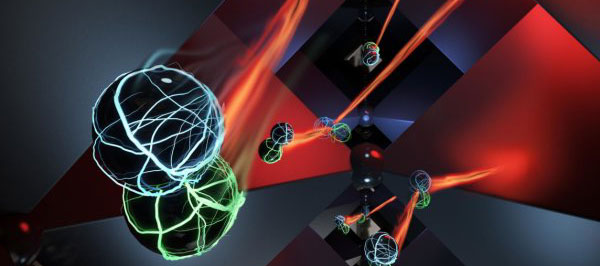Scientists have discovered that a highly promising group of materials known as hybrid lead halide perovskites can recycle light – a finding that they believe could lead to large gains in the efficiency of solar cells.
Hybrid lead halide perovskites are a particular group of synthetic materials which have been the subject of intensive scientific research, as they appear to promise a revolution in the field of solar energy. As well as being cheap and easy to produce, perovskite solar cells have, in the space of a few years, become almost as energy-efficient as silicon – the material currently used in most household solar panels.
By showing that they can also be optimised to recycle light, the new study suggests that this could just be the beginning. Solar cells work by absorbing photons from the sun to create electrical charges, but the process also works in reverse, because when the electrical charges recombine, they can create a photon. The research shows that perovskite cells have the extra ability to re-absorb these regenerated photons – a process known as “photon recycling”. This creates a concentration effect inside the cell, as if a lens has been used to focus lots of light in a single spot.
According to the researchers, this ability to recycle photons could be exploited with relative ease to create cells capable of pushing the limits of energy efficiency in solar panels.
The study builds on an established collaboration, focusing on the use of these materials not only in solar cells but also in light-emitting diodes, and was carried out in the group of Richard Friend, Cavendish Professor of Physics and Fellow of St John’s College at the University of Cambridge. The research was undertaken in partnership with the team of Henry Snaith at the University of Oxford and Bruno Ehrler at the FOM Institute, AMOLF, Amsterdam.
Felix Deschler, who is one of the corresponding authors of the study and works with a team studying perovskites at the Cavendish Laboratory, said: “It’s a massive demonstration of the quality of this material and opens the door to maximising the efficiency of solar cells. The fabrication methods that would be required to exploit this phenomenon are not complicated, and that should boost the efficiency of this technology significantly beyond what we have been able to achieve until now.”
Perovskite-based solar cells were first tested in 2012, and were so successful that in 2013, Science Magazine rated them one of the breakthroughs of the year.
Since then, researchers have made rapid progress in improving the efficiency with which these cells convert light into electrical energy. Recent experiments have produced power conversion efficiencies of around 20% – a figure already comparable with silicon cells.
By showing that perovskite-based cells can also recycle photons, the new research suggests that they could reach efficiencies well beyond this.
The study, which is reported in Science, involved shining a laser on to one part of a 500 nanometre-thick sample of lead-iodide perovskite. Perovskites emit light when they come into contact with it, so the team was able to measure photon activity inside the sample based on the light it emitted.
Close to where the laser light had shone on to the film, the researchers detected a near-infrared light emission. Crucially, however, this emission was also detected further away from the point where the laser hit the sample, together with a second emission composed of lower-energy photons.
“The low-energy component enables charges to be transported over a long distance, but the high-energy component could not exist unless photons were being recycled,” Luis Miguel Pazos Outón, a co-author on the study, said. “Recycling is a quality that materials like silicon simply don’t have. This effect concentrates a lot of charges within a very small volume. These are produced by a combination of incoming photons and those being made within the material itself, and that’s what enhances its energy efficiency.”
As part of the study, Pazos Outón also manufactured the first demonstration of a perovskite-based back-contact solar cell. This single cell proved capable of transporting an electrical current more than 50 micrometres away from the contact point with the laser; a distance far greater than the researchers had predicted, and a direct result of multiple photon recycling events taking place within the sample.
The researchers now believe that perovskite solar cells, may be able to reach considerably higher efficiencies than they have to date. “The fact that we were able to show photon recycling happening in our own cell, which had not been optimised to produce energy, is extremely promising,” Richard Friend, a corresponding author, said. “If we can harness this it would lead to huge gains in terms of energy efficiency.”
Reference(s):
Publication: L. M. Pazos-Outon, M. Szumilo, R. Lamboll, J. M. Richter, M. Crespo-Quesada, M. Abdi-Jalebi, H. J. Beeson, M. Vru ini , M. Alsari, H. J. Snaith, B. Ehrler, R. H. Friend, F. Deschler. Photon recycling in lead iodide perovskite solar cells. Science, 2016
Story: St John’s College, University of Cambridge













Comments